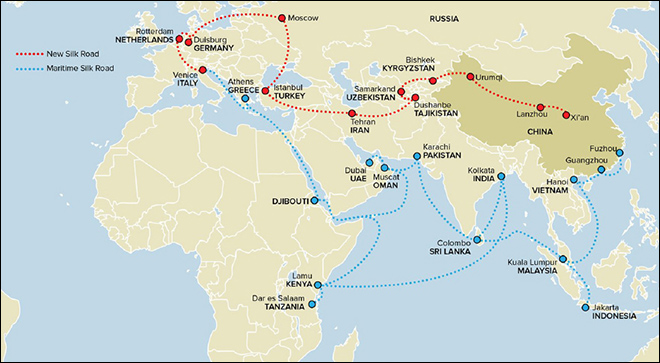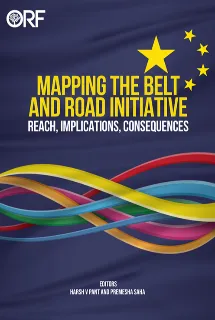Introduction
China’s Belt and Road Initiative (BRI), launched in 2013 by President Xi Jinping during official visits to Kazakhstan and Indonesia, is among the world’s most ambitious infrastructure projects ever conceived. It is a union of development and investment initiatives that would stretch from East Asia to Europe, and in the process significantly expand China’s economic and political influence in these massive regions. The plan, initially named ‘One Belt, One Road’, is two-pronged: the overland Silk Road Economic Belt, and the Maritime Silk Road. On land, Beijing aims to connect the country’s underdeveloped hinterland to Europe through Central Asia; the maritime component will build ports and railways to connect the fastgrowing Southeast Asian region to China’s southern provinces.
At the time of publishing this report, more than 60 countries—home to nothing less than two-thirds of the world’s population—have signed on to BRI projects, or else have indicated an interest. Morgan Stanley has predicted that China’s overall expenses over the entire duration of the BRI could reach $1.2–1.3 trillion by 2027. Two years after Xi announced the initiative, three coordinating government agencies (the National Development and Reform Commission, the Ministry of Foreign Affairs, and the Ministry of Commerce) issued in 2015 the first official blueprint on what was then still called OBOR, the ‘Vision and Actions on Jointly Building Silk Road Economic Belt and 21st Century Maritime Silk Road’.

The infrastructure development plan aims to create a vast network of railways, energy pipelines, highways, and some 50 special economic zones—all of which would expand the international use of Chinese currency, the Renminbi and, thus declared Xi, “break the bottleneck in Asian connectivity.” Viewed from the geopolitical lens, Beijing’s aim, through the BRI, is to strengthen its economic leadership while gaining political leverage over its neighbours and asserting its presence on the global stage. In other words, China’s BRI stands on the pillars of both geopolitical and economic motivations. It runs parallel to China’s growing assertiveness in its bilateral relations, as seen in its increasingly hawkish actions in its immediate region and beyond. At the same time, trade relations with the United States have faced setbacks, thereby pressuring the Chinese government to find new markets for its commodities.
The BRI, however, is not only an initiative; it is a response: for one, to former US President Barack Obama’s ‘pivot to Asia’; and to the growing salience of the Indo-Pacific maritime geography as well. In recent years, the IndoPacific has become central to the security and foreign policies of countries like the US, Japan, Australia, India, the UK, France, Germany, and the countries of ASEAN. China is working to strengthen global economic links to its western regions, which historically have been neglected. Promoting economic development in the western province of Xinjiang, where the Communist Party of China has waged a brutal campaign of intimidation and violence against the Uighur Muslims, is seen as a priority. So is securing long-term energy supplies from Central Asia and the Middle East.
China has captured the world’s attention by demonstrating the urgency of boosting infrastructure development and transnational connectivity as the next stage of economic globalisation. Other global powers have been forced to respond to China with their own infrastructure and connectivity plans; the demand is high, and China is the first power to try to fill it. As it does so, Beijing appears to be falling into similar patterns of conflict.
Indeed, the challenges are growing. The story of Sri Lanka, for example, being saddled by the burden of unsustainable debt to China is well-documented. In 2018, former Malaysian President Mahathir Mohamad suspended work on certain BRI ventures in his country over concerns of mounting debts to China. For similar reasons, the government of Myanmar has significantly scaled down the Kyaukpyu port project. In Pakistan, too, the voices against the conditionalities tied to Chinese activities and loans have grown louder. India, for its part, had taken an early stance against the BRI and refused to participate in the inaugural Belt and Road Forum in 2017. It had long emphasised that connectivity projects should respect the participating country’s sovereignty and territorial integrity, not create unsustainable debt burden, involve transparent accounting, and create benefits for the local economy.
It is clear that China’s ambitions to recreate its ancient Silk Route—massive as they are and couched in grand rhetoric of development and connectivity—are not going to remain unchallenged. China’s success will depend on its ability to move beyond the bilateral framework and allow a truly multilateral vision for the project to evolve. Otherwise, the People’s Republic can expect to contend with stronger opposition from more countries other than India. Japan, for instance, along with India have unveiled their own development cooperation with third countries under the banner of the Asia-Africa Growth Corridor. The US, meanwhile, has launched a new development finance institution, the US International Development Finance Corporation (USIDFC) to compete with the AIIB. And the US and Australia have joined Japan in announcing plans through the Blue Dot Network for an alternative to BRI.
This monograph offers definitive analyses of multiple aspects of the BRI, authored by research scholars of the Strategic Studies Programme of ORF. The first section, ‘Pivotal Geographies’, outlines the progress so far of projects under the BRI in the regions of South Asia, Southeast Asia, Oceania, Africa, West Asia, Central Asia and Latin America, and the challenges they face. The second section, ‘Global Powers and their Responses to the BRI’, analyses the responses of countries and regions like the United States, Japan, European Union and Russia. The chapters in the last section offer various lenses to view the BRI against: legal, defence and security, and financial viability. Evolving debates on the Maritime Silk Road are discussed in this section as well, along with the Health Silk Road, and the emergence of the Indo-Pacific construct as a counter-narrative to the BRI.
This monograph offers an in-depth analysis of the BRI—perhaps the most widely contested narrative of this scale in contemporary global geopolitics. It aims to generate wider discussions on the subject, in India and beyond. In this era of global politics when Chinese belligerence is heightening alongside its expanding global footprint, India and the world must recognise how the BRI is aiming to reshape the global order in fundamental ways. Such an understanding can serve as an anchor for an appropriate response to the China challenge. This monograph is ORF’s endeavour to contribute to this understanding.
The views expressed above belong to the author(s). ORF research and analyses now available on Telegram! Click here to access our curated content — blogs, longforms and interviews.

 PDF Download
PDF Download




 PREV
PREV



